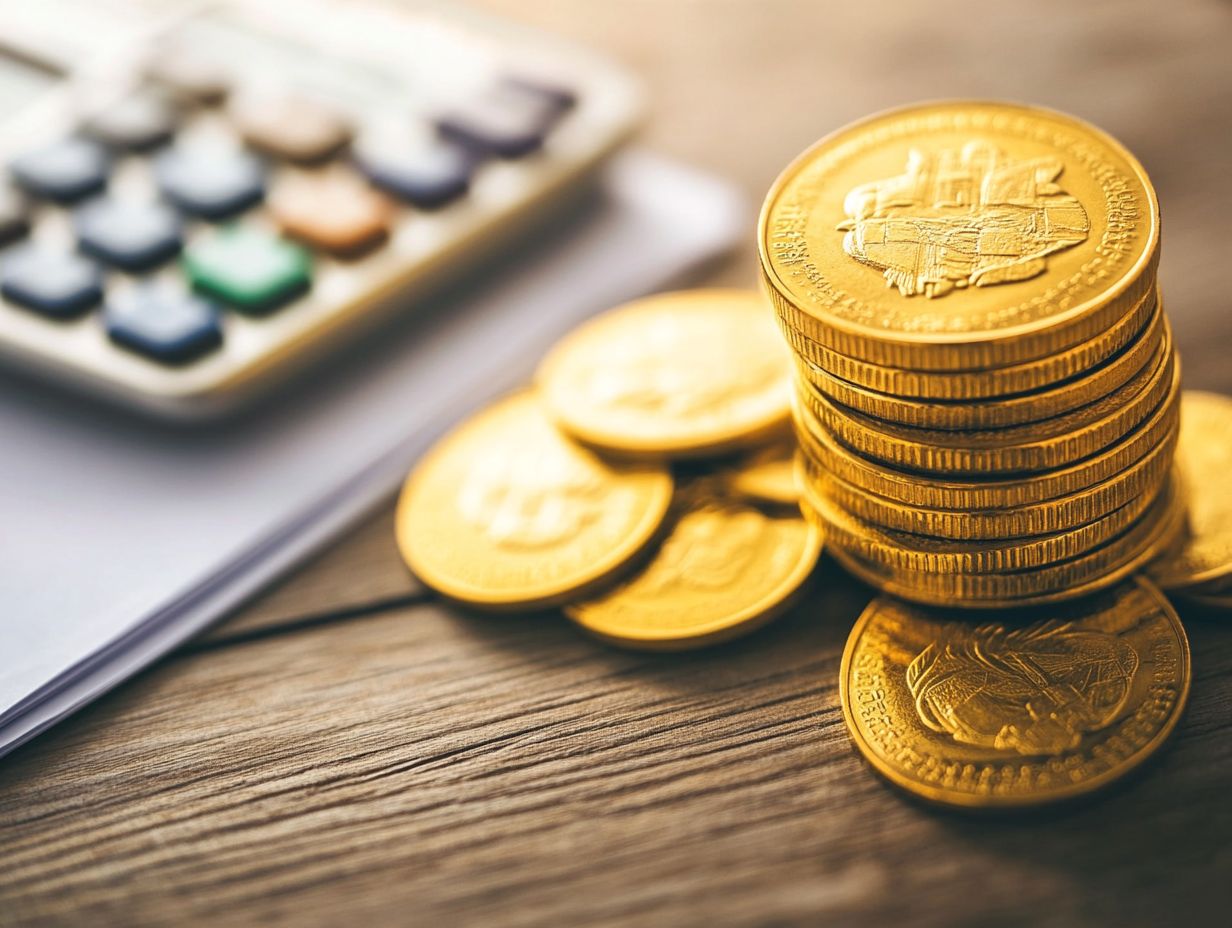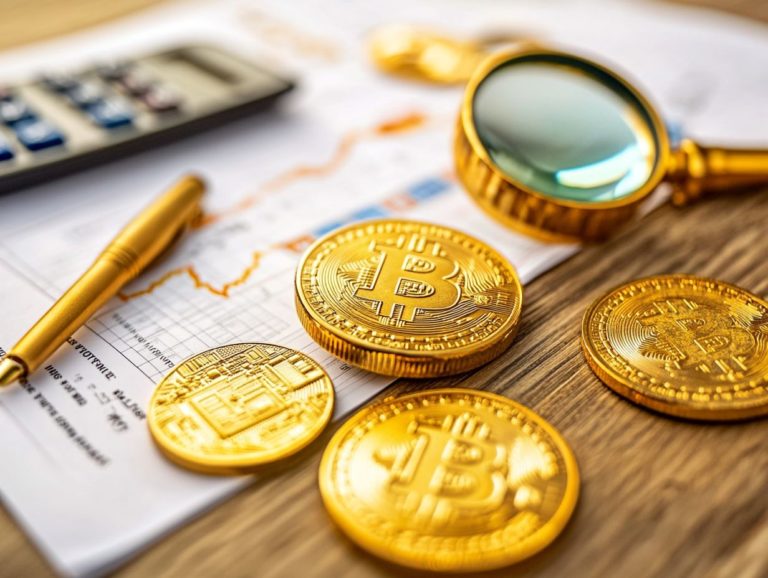Investing in Gold: A Beginner’s Guide
Gold has fascinated investors for centuries, standing as a timeless symbol of wealth and stability. As you explore this asset class, you’ll discover its unique combination of safety and growth potential, making it an alluring choice whether you re a seasoned investor or just starting out.
Dive into this essential guide to gold investing and unlock your financial future today! This guide delves into the essentials of gold investing, highlighting its benefits, various investment methods such as physical gold, ETFs (exchange-traded funds), and mining stocks and the critical factors you should consider before making your move.
Get ready to discover essential tips that will help you confidently navigate the gold market! Whether you’re looking to diversify your portfolio or hedge against economic uncertainty, this article equips you with the knowledge needed to make informed decisions in the dynamic world of gold investing.
Contents
Key Takeaways:

- Understand what gold investing is and the reasons why it can be a valuable addition to your investment portfolio.
- Consider various ways to invest in gold, such as physical gold, ETFs, and gold mining stocks, and choose the option that aligns with your risk tolerance and investment goals.
- Keep in mind important factors like risk, market trends, and diversification when investing in gold, and stay updated and vigilant in monitoring your investments to maximize potential returns.
The Basics of Investing in Gold
Investing in gold is a time-honored strategy that capitalizes on the historical significance of gold as a valuable item, offering you both a hedge against inflation and a reliable refuge during periods of market volatility.
In recent years, you may have noticed that gold has garnered considerable attention from investors eager to diversify their portfolios amid economic downturns and financial crises. Its unique attributes as a item you can hold make it a compelling choice that stands the test of time.
To truly understand the fundamentals of investing in gold, you should explore various options available to you, including physical gold, gold securities, and gold-backed assets. Additionally, if you’re interested in diversifying your portfolio, consider investing in silver. Each of these can elevate your investment strategies and fortify your overall financial resilience.
What is Gold Investing?
Gold investing encompasses a range of strategies and options for acquiring and holding gold as an asset. This includes everything from physical gold, such as coins and bullion, to financial products like gold-backed stocks and gold IRAs.
In today s financial landscape, gold stands as a crucial safeguard against inflation and economic uncertainty, attracting both seasoned investors and newcomers. Physical gold, especially in the form of coins and bullion, offers tangible value and security, making it a popular choice due to its intrinsic worth.
Gold-backed assets deliver convenience and liquidity, allowing you to invest in stocks or mutual funds that are directly tied to gold prices. Gold IRAs provide a specialized retirement option, enabling you to diversify your portfolio with precious metals while enjoying tax advantages. By understanding these avenues, you empower yourself to make informed decisions that protect and grow your wealth.
Why Invest in Gold?
Investing in gold presents you with a range of compelling advantages, including its esteemed reputation as a hedge against inflation, a strategic tool for navigating market volatility, and a trustworthy safe haven during financial crises.
One of the primary reasons you might consider gold is its historical prowess in maintaining value when traditional currencies struggle. During economic downturns, gold often appreciates as investors flock to stability, cementing its position as a reliable investment choice.
As inflation chips away at your purchasing power, gold also acts as a protective barrier, ensuring your wealth remains intact. By diversifying your portfolio with gold, you can create a cushion against market fluctuations, effectively balancing the risks associated with more volatile assets.
As market dynamics evolve, you’ll likely discover that incorporating gold not only grants you immediate security but also fosters long-term financial health.
Ready to invest in gold? Start your journey towards financial security today!
Ways to Invest in Gold
You have several options for investing in gold, each offering distinct advantages and challenges.
Consider purchasing physical gold, such as coins and bullion, for a tangible asset.
You can also explore gold exchange-traded funds (ETFs). These provide a more liquid investment avenue.
Lastly, buying shares in gold mining stocks can offer exposure to the gold market while benefiting from the mining companies operations.
Each method presents its own set of opportunities and risks. This allows you to tailor your investment strategy to your preferences.
Physical Gold

Physical gold investments include tangible assets like gold coins and bullion. These offer a reliable store of value and a versatile investment option.
Gold is incredibly durable. It withstands wear and tear better than many other investments.
If you re looking to acquire such assets, it’s wise to seek out reputable precious metal dealers. They can provide a variety of gold products, ensuring you receive quality and authenticity.
Once you’ve made your purchase, understanding secure gold storage is vital protect your investment today!
Safeguarding your investments from theft or damage is paramount. Whether you choose a bank safe deposit box or a home safe designed for valuables, the protection of your physical gold should be a top priority for any astute investor.
Gold Exchange-Traded Funds (ETFs)
Gold Exchange-Traded Funds (ETFs) are investment vehicles designed to track the price of gold. They offer you a convenient way to gain exposure without the hassle of physically holding the asset.
These financial instruments enable you to buy shares that represent ownership in a pool of gold-backed assets. This streamlines transactions compared to purchasing and storing physical gold.
One standout advantage of gold ETFs is their liquidity. You can easily buy and sell shares on stock exchanges, much like trading stocks.
They often come with lower transaction costs and storage fees compared to managing physical gold.
However, it’s essential to weigh the potential drawbacks as well. Market volatility and management fees can eat into your investment returns.
While gold ETFs respond to market dynamics, they may not always perfectly reflect the actual gold price. This can be due to factors like the fund’s operating costs and the demand for ETF shares.
Gold Mining Stocks
Investing in gold mining stocks provides you with a unique way to gain exposure to gold prices. This allows you to benefit from the operational success of mining companies and their production levels.
This type of investment acts as a leveraged play on gold prices. When gold shines, these stocks often experience even greater gains.
However, it’s crucial to assess your risk tolerance. Fluctuations in mining operations, shifts in regulatory environments, and broader market dynamics can all influence your returns.
Incorporating gold mining stocks into your investment strategy can enhance your portfolio s diversification.
Finding the right balance between the potential for substantial rewards and the inherent risks associated with the mining industry is essential.
Factors to Consider Before Investing in Gold
Before you invest in gold, it s essential to carefully assess a few key factors.
Consider your risk tolerance, keep an eye on current market trends, and think about how fluctuations in gold prices could impact your investment strategies, especially during economic downturns.
Risk and Return
Understanding the relationship between risk and return is crucial for you as a gold investor. Don t miss out on maximizing your investment potential during market fluctuations! Fluctuating gold prices can have a substantial impact on your investment returns, particularly during periods of market volatility and economic downturn.
In today s intricate financial landscape, if you re considering gold as a safe-haven asset, it s important to weigh your risk tolerance against potential returns. Gold often acts as a hedge to protect against rising prices and currency devaluation, making it a compelling choice in uncertain times.
If you have a low risk tolerance, investing in gold may feel daunting. Its price can be volatile, especially during unstable markets. On the flip side, if you re open to taking on a higher level of risk, you may discover rewarding opportunities during declining economic conditions, as gold often appreciates when traditional stocks struggle.
Therefore, assessing your investment strategy becomes imperative.
Market Trends and Timing

Watching market trends and understanding gold price movements is crucial for refining your investment timing. Keeping a close watch on these trends can significantly broaden your overall options.
For those intrigued by gold futures, it s essential to recognize how external economic factors like inflation rates and geopolitical tensions shape market sentiment. Analyzing historical data alongside current trends can offer valuable insights into the optimal moments for entering or exiting positions.
By employing a range of investment strategies, such as leveraging technical analysis to analyze historical price movements and predict future trends or keeping an eye on expert forecasts, you can navigate the volatility often tied to gold prices with greater confidence. Additionally, understanding the risks and rewards of silver investing ultimately equips you with the knowledge to make informed decisions that align perfectly with your financial aspirations.
Tips for Successful Gold Investing
Successful gold investing demands a strategic approach that emphasizes portfolio diversification and well-considered choices. It’s essential to base your investments on thorough research and a deep understanding of gold ownership.
Diversifying Your Portfolio
Diversifying your portfolio by incorporating gold-backed assets and physical gold coins serves as an effective buffer against market volatility and economic crises.
This strategy secures your wealth and strengthens your financial position. During periods of economic uncertainty or stock market declines, you ll often find that gold retains its value, acting as a reliable safe haven.
By adding this precious metal to your investment mix, you can effectively offset potential losses from other assets that are more vulnerable to market swings. Historically, gold has demonstrated an inverse relationship with various financial instruments, making it a valuable hedge against inflation and currency devaluation. This ultimately contributes to your greater financial stability.
Staying Informed and Monitoring Your Investments
Staying informed about market trends and continuously monitoring your investments is crucial for maximizing returns and effectively managing your gold investments. In today’s dynamic financial landscape, this awareness enables you to navigate the fluctuations in gold prices and the broader economy with confidence.
By integrating comprehensive monitoring techniques, such as trend analysis and price alerts, you can make proactive decisions that align with your investment strategies. Ultimately, adopting a methodical approach to tracking these factors is essential for fostering confidence in your financial ventures and securing a favorable position in the ever-evolving investment market.
Frequently Asked Questions
What is gold investing?

Gold investing means buying and holding either physical gold or related assets to profit from price increases or dividends. It is considered a safe-haven investment and can serve as a hedge against inflation and economic uncertainty.
Why should I consider investing in gold?
Gold has proven to be a stable and valuable asset over time. It s a popular choice for investors because it can diversify a portfolio and act as a hedge against economic downturns.
Gold also has the potential for long-term growth and serves as a reliable store of value during crises.
What are the different ways to invest in gold?
You can invest in gold in several ways. Options include buying physical gold like coins or bars, investing in gold mining stocks, purchasing gold exchange-traded funds (ETFs), or trading gold futures contracts.
Each method has its benefits and risks, so it s crucial to research and understand your options before jumping in.
How do I determine the value of gold?
The value of gold is determined by its purity and weight. Prices fluctuate due to supply, demand, and various economic and political factors.
Stay informed about these factors and keep an eye on the current market price when buying or selling gold.
What are the risks associated with investing in gold?
Like any investment, gold comes with risks. Its price can be volatile and may not always increase in value.
Additionally, owning physical gold may lead to extra costs for storage and insurance. Carefully consider these risks before making investment decisions.
Is gold investing suitable for beginners?
Gold investing is a fantastic option for beginners looking for stability! It offers a tangible asset that’s relatively stable.
However, beginners should educate themselves about the various ways to invest and consider their risk tolerance and investment goals. Consulting a financial advisor can also be helpful.















